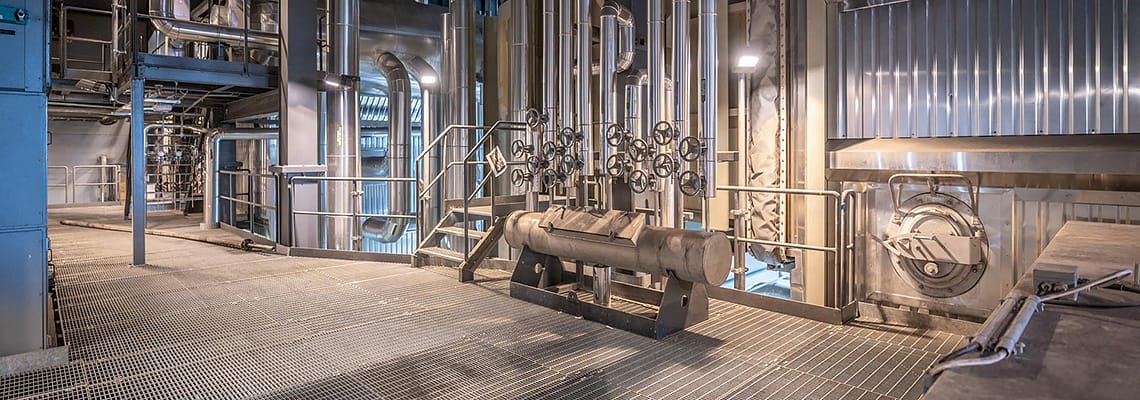Our services for industrial builders
We provide fire safety engineering for all delivery methods in industrial projects, including EPC, EPCM, and EPS deliveries, during both basic and detailed design phases.
Basic engineering phase
- analysis of fundamental fire safety principles, alternatives, and opportunities for cost savings through performance-based fire safety design without compromising fire safety
- fire engineering consulting
- preliminary fire protection plan
- other fire safety assessments (e.g., preliminary evacuation route and fire suppression water plan)
- in projects implemented abroad, assessment/validation of regulatory requirements and translation of design documents (if needed).
Detailed engineering phase
- fire safety planning for building permit documentation
- performance-based fire safety design
- plans for smoke clearance
- design of automatic fire extinguishing systems
- expert statements
- fire block design
- other fire safety assessments
Building or equipment?
The Ministry of the Environment’s Decree 848/2017 concerning fire safety in buildings focuses, as its name suggests, on buildings. In industrial sites, it is often assessed whether it is a equipment or a building. It is essential to understand the operation of an industrial building or device on-site to ensure personnel safety, uninterrupted operation of the production facility, and minimize potential property damage using the best and the most cost-effective possible fire safety planning solutions.
Industrial buildings include various facilities such as energy production plants and related buildings like electrical, turbine, storage, and other production facilities, industry plants such as paper and pulp mills, chemical industry plants, mining and metallurgical plants, bioproduct mills and mechanical forest industry facilities. Industrial sites closer to being equipments rather than buildings include, for example, conveyor and pipe bridges, light weather shelters for pumps and other equipment, silos, transformers, and various container solutions. When considering a facility as equipment, the design must adhere to relevant machinery safety and electrical standards according to the project’s design criteria.
Escape routes and firefighting operations
In the planning of evacuation routes and firefighting operations, it is essential to consider the specific characteristics of production areas, manufacturing facilities, and warehouse buildings. Additional challenges may include preparing for chemical spills and protecting against them in the event of a fire, as well as designing and locating pressure relief vents. The evacuation route must be accessible in all weather conditions, and wind direction can be a crucial factor in firefighting. The wind direction should be considered, for instance, if access to the firefighting foam station is necessary in all fire situations. Essential information is also obtained, for example, from thermal radiation dispersion modeling in areas storing flammable liquids, and from explosion protection documents for ATEX classified zones and ATEX equipment. In large factory sites, there is often an on-site fire brigade whose task is to initiate firefighting operations as quickly as possible in the event of a fire. Important considerations also include ensuring an adequate supply of firefighting water with the appropriate firefighting water system and designing collection systems for used firefighting water.
Designing evacuation routes
When planning evacuation routes within an industrial building, in addition to the aforementioned factors, it is important to consider the specific use of each room or space. It is important to know whether the spaces are occupied permanently or temporarily, or if the areas are completely unoccupied, and to estimate the likely number of people in different parts of the building during use. Especially during maintenance shutdowns, the number of people present may unexpectedly increase significantly. During such times, it is essential to ensure that evacuation routes are adequate in terms of both their number and width. In large warehouse-like buildings, a significant issue can arise due to the long distance to the nearest exit. One possible solution is to design a compartmentalized exit route that starts from the center or near the central area of a large hall-like space, without disrupting potential production activities. Exiting through the roof or basement can also be a solution, although in this case, requirements for compartmentalized exit routes and firefighting access in the basement must be considered.
Automatic fire extinguishing systems
An automatic fire extinguishing system is often necessary, for instance, in large fire compartments or to meet the fire resistance requirements of load-bearing structures as per Regulation 848/2017. In these cases, the automatic fire extinguishing system provides overall protection for the entire building. In some cases, however, it is justified to implement a fire suppression system only in part of the building, targeted to specific risks, such as around a concentration of fire load or potential ignition sources, to prevent the spread of fire. In such cases, the protection level may not fully comply with all requirements of the sprinkler standard SFS-EN 12845. The scope and type of system (such as water sprinklers, water mist, gas, aerosol) also impact insurance premiums, which should be considered when selecting design solutions.
Fire resistance requirements for structures
The structural integrity requirements, including the fire resistance requirements of load-bearing structures in fire situations, are determined according to Regulation 848/2017, based on factors such as the maximum number of floors in the building. Often under consideration is how to best design facilities where a large, single-story production plant includes multilevel sections with potentially significant fire loads. The solution should also take into account the production activities within the building and the possibilities of implementing fire compartments or constructing firewalls between different parts of the building. Consideration also remains whether automatic fire extinguishing systems can provide relief for structural integrity requirements. For example, whether implementation should adhere to the highest number of floors throughout the entire building or if compliance with structural integrity requirements can be demonstrated through performance-based fire design. Appropriate site-specific solutions are always negotiated with local building control and fire safety authorities.
Fire compartmentation requirements
Implementing fire compartmentation requirements in production buildings is often challenging and requires specialized expertise from the designer. In addition to large fire compartment sizes, other important considerations include penetrations through compartmentalized building elements. How is the compartmentation solution for large openings in fire compartment walls, such as truck routes, implemented? Do we need target protection around the opening, or is there a reliable fire door solution available that can withstand the intended use, or is a combination of these options required? How do we ensure that the opening in the wall structure is always closed and that there cannot be, for example, a broken-down truck left at the door? Similar challenges also apply to conveyor penetration solutions in fire compartmentalized structures. How do we ensure that there is no gap left under the conveyor belt and that the conveyor belt itself does not pose a fire load if compartmentation is to be implemented using guillotine solutions? Other considerations include the risk of ignition from conveyor belt motors and the material and fire properties of the conveyed material, conveyor belts, and hydraulic and lubrication oils.
Benefits obtained through competent fire safety engineer
Fire safety design for an industrial building project should always be entrusted to a knowledgeable and qualified fire safety engineer, as the design task is much more complex than fire safety design for buildings with other purposes. Additionally, the conditions of the industrial operation guide the overall fire safety design. A qualified fire safety engineer knows how to consider the possibilities of using performance-based fire design in their planning. This results in cost savings without compromising fire safety, while also reducing the adverse environmental impacts of the industrial site.
More information
For more information on the fire safety planning of industrial sites:
Take Contact
Explore our industrial project references and feel free to request a presentation of our services if needed.


